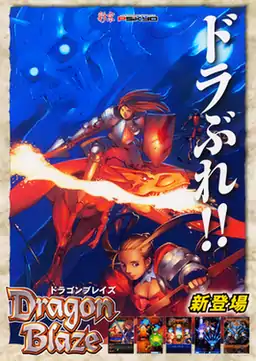Dragon Blaze
Dragon Blaze is a shoot 'em up arcade game developed and published in 2000 by Psikyo. It was ported to the PlayStation 2 as part of Taito's Psikyo Shooting Collection Vol. 3: Sol Divide & Dragon Blaze compilation in 2005.[1] The game was later also released on its own as a budget range title for the PlayStation 2 in Europe by 505 Games on 2006.[2] In 2018 the game was ported to the Nintendo Switch by ZeroDiv as part of their series of re-releases of classic Psikyo games.[3]
| Dragon Blaze | |
|---|---|
 | |
| Developer(s) | Psikyo |
| Publisher(s) | Psikyo |
| Platform(s) | Arcade, PlayStation 2, Nintendo Switch |
| Release | Arcade: 2000 PlayStation 2: 2006 Nintendo Switch: 2018 |
| Genre(s) | Scrolling shooter |
| Mode(s) | Single-player, multiplayer |
Gameplay
Dragon Blaze plays like many typical 2D vertically scrolling shooters by Psikyo, although this game is closer to the bullet hell genre than most of the company's other output and the colour of the enemies' bullets has been changed from Psikyo's trademark orange to a neon purple. The game gives each character the standard normal shot, charged shot, and magic bomb, but each character (Quaid, Sonia, Ian, Rob) also rides a dragon, which can be dismounted and be used as a weapon itself. The dismounted dragon initially acts as a piercing weapon, and then remains stationary shooting until the player calls it back using the same button. It can also be used to collect items.[4]
Reception
In Japan, Game Machine listed Dragon Blaze on their November 1, 2000 issue as being the fourth most-successful arcade game of the year.[5]
References
- "彩京シューティングコレクション Vol.3 ソルディバイド&ドラゴンブレイズ | ソフトウェアカタログ | プレイステーション® オフィシャルサイト". Jp.playstation.com. Retrieved 2016-09-08.
- "Dragon Blaze for PlayStation 2". GameRankings. 2006-06-23. Retrieved 2016-09-08.
- "Dragon Blaze Nintendo Switch Review - SwitchWatch". SwitchWatch. 2018-04-06. Retrieved 2018-04-08.
- "ドラゴンブレイズ SYSTEM". Psikyobabble.com. Retrieved 2016-09-08.
- "Game Machine's Best Hit Games 25 - TVゲーム機ーソフトウェア (Video Game Software)". Game Machine (in Japanese). No. 621. Amusement Press, Inc. 1 November 2000. p. 21.
External links
- Official website (in Japanese)
- Dragon Blaze at the Killer List of Videogames
- Dragon Blaze at Hardcore Gaming 101
- Dragon Blaze at the International Arcade Museum
- Dragon Blaze at World of Arcades